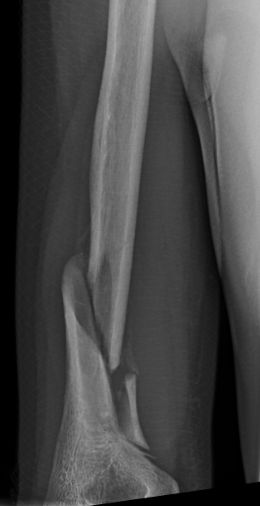Holstein–Lewis fracture

Editor-In-Chief: Prab R Tumpati, MD
Obesity, Sleep & Internal medicine
Founder, WikiMD Wellnesspedia &
W8MD medical weight loss NYC and sleep center NYC
| Holstein–Lewis fracture | |
|---|---|
 | |
| Synonyms | Distal third humeral shaft fracture |
| Pronounce | N/A |
| Specialty | N/A |
| Symptoms | Pain, swelling, inability to move the arm |
| Complications | Radial nerve palsy |
| Onset | Sudden, due to trauma |
| Duration | Varies, depending on treatment |
| Types | N/A |
| Causes | Trauma, such as a fall or direct blow |
| Risks | Osteoporosis, high-impact sports |
| Diagnosis | X-ray, Physical examination |
| Differential diagnosis | Other types of humerus fracture |
| Prevention | N/A |
| Treatment | Surgery, Immobilization |
| Medication | Pain management |
| Prognosis | Generally good with treatment |
| Frequency | Rare |
| Deaths | N/A |
Holstein–Lewis fracture is a specific type of distal radius fracture that occurs in the forearm. Named after American orthopedic surgeons Arthur Holstein and Gwilym Lewis, this fracture is characterized by a spiral break in the distal third of the radius, one of the two long bones in the forearm.
Anatomy[edit]
The radius is one of the two long bones in the forearm, the other being the ulna. The radius is located on the thumb side of the forearm and is responsible for the majority of the forearm's rotation. The distal end of the radius, near the wrist, is a common site for fractures.
Mechanism of Injury[edit]
Holstein–Lewis fractures typically occur as a result of a fall onto an outstretched hand (FOOSH). The force of the fall causes the radius to break in a spiral pattern, often with displacement of the bone fragments.
Diagnosis[edit]
Diagnosis of a Holstein–Lewis fracture is typically made through a combination of physical examination and radiography. On a radiograph, the fracture appears as a spiral break in the distal third of the radius.
Treatment[edit]
Treatment for a Holstein–Lewis fracture typically involves reduction, the process of realigning the broken bone fragments, followed by immobilization in a cast or splint. In some cases, surgery may be required to stabilize the fracture and ensure proper healing.
Complications[edit]
One of the most common complications associated with Holstein–Lewis fractures is injury to the radial nerve, which runs near the site of the fracture. This can result in symptoms such as numbness, tingling, or weakness in the hand and wrist.
See Also[edit]
Ad. Transform your life with W8MD's Budget GLP-1 injections from $75


W8MD offers a medical weight loss program to lose weight in Philadelphia. Our physician-supervised medical weight loss provides:
- Weight loss injections in NYC (generic and brand names):
- Zepbound / Mounjaro, Wegovy / Ozempic, Saxenda
- Most insurances accepted or discounted self-pay rates. We will obtain insurance prior authorizations if needed.
- Generic GLP1 weight loss injections from $75 for the starting dose.
- Also offer prescription weight loss medications including Phentermine, Qsymia, Diethylpropion, Contrave etc.
NYC weight loss doctor appointmentsNYC weight loss doctor appointments
Start your NYC weight loss journey today at our NYC medical weight loss and Philadelphia medical weight loss clinics.
- Call 718-946-5500 to lose weight in NYC or for medical weight loss in Philadelphia 215-676-2334.
- Tags:NYC medical weight loss, Philadelphia lose weight Zepbound NYC, Budget GLP1 weight loss injections, Wegovy Philadelphia, Wegovy NYC, Philadelphia medical weight loss, Brookly weight loss and Wegovy NYC
|
WikiMD's Wellness Encyclopedia |
| Let Food Be Thy Medicine Medicine Thy Food - Hippocrates |
Medical Disclaimer: WikiMD is not a substitute for professional medical advice. The information on WikiMD is provided as an information resource only, may be incorrect, outdated or misleading, and is not to be used or relied on for any diagnostic or treatment purposes. Please consult your health care provider before making any healthcare decisions or for guidance about a specific medical condition. WikiMD expressly disclaims responsibility, and shall have no liability, for any damages, loss, injury, or liability whatsoever suffered as a result of your reliance on the information contained in this site. By visiting this site you agree to the foregoing terms and conditions, which may from time to time be changed or supplemented by WikiMD. If you do not agree to the foregoing terms and conditions, you should not enter or use this site. See full disclaimer.
Credits:Most images are courtesy of Wikimedia commons, and templates, categories Wikipedia, licensed under CC BY SA or similar.
Translate this page: - East Asian
中文,
日本,
한국어,
South Asian
हिन्दी,
தமிழ்,
తెలుగు,
Urdu,
ಕನ್ನಡ,
Southeast Asian
Indonesian,
Vietnamese,
Thai,
မြန်မာဘာသာ,
বাংলা
European
español,
Deutsch,
français,
Greek,
português do Brasil,
polski,
română,
русский,
Nederlands,
norsk,
svenska,
suomi,
Italian
Middle Eastern & African
عربى,
Turkish,
Persian,
Hebrew,
Afrikaans,
isiZulu,
Kiswahili,
Other
Bulgarian,
Hungarian,
Czech,
Swedish,
മലയാളം,
मराठी,
ਪੰਜਾਬੀ,
ગુજરાતી,
Portuguese,
Ukrainian
